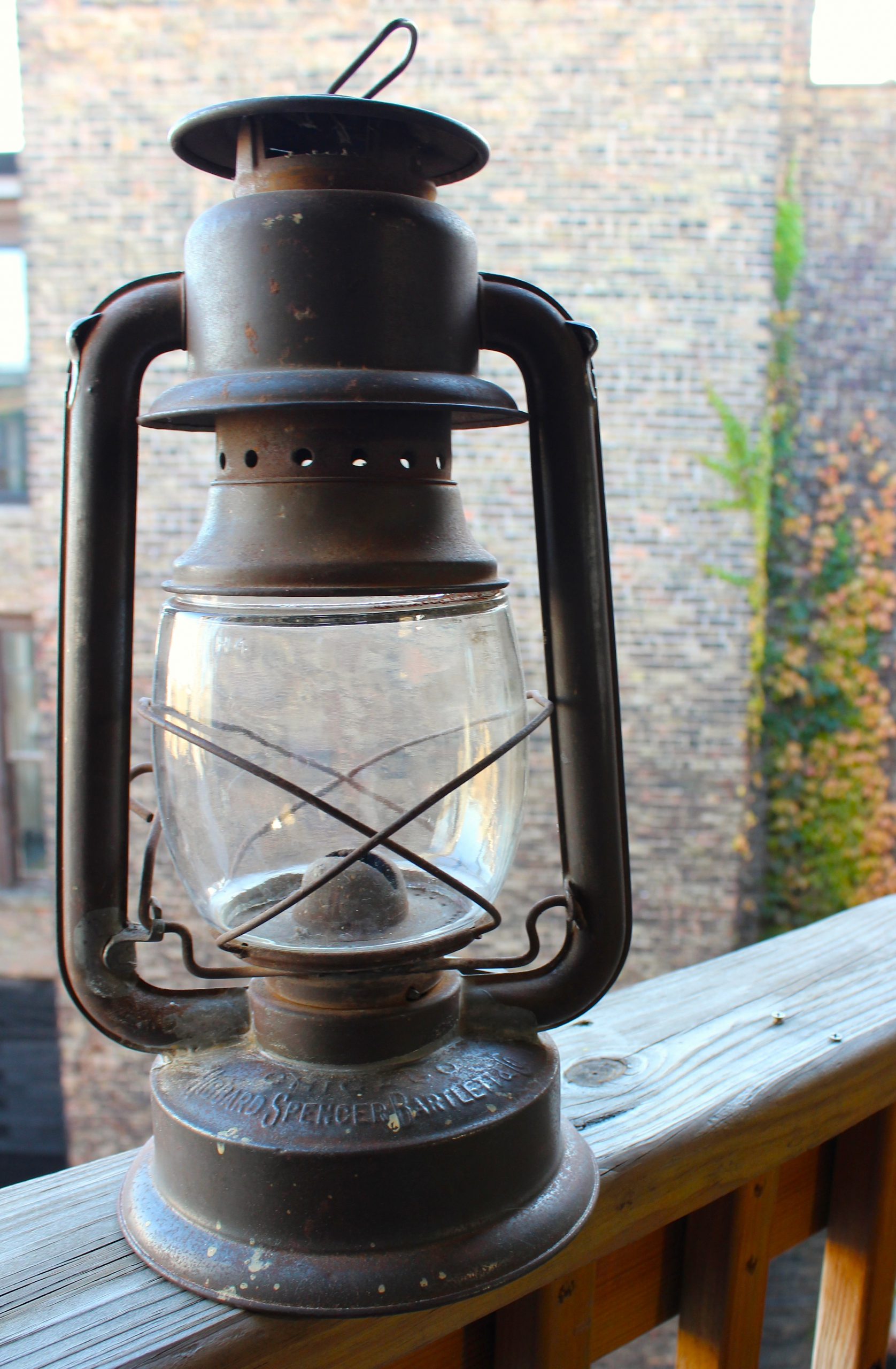
Museum Artifact: OVB No. 2 Kerosene Lantern, c. 1920s
Made By: Hibbard Spencer Bartlett & Co., 211 E. North Water Street [Downtown/The Loop]
“Hardware seems to those who sell it to be more human than any other kind of business.” That’s how journalist Fred C. Kelly sized up the stock and trade of Hibbard, Spencer & Bartlett in 1930, on the occasion of the wholesale company’s 75th anniversary. Kelly, who later became far better known as a biographer of the Wright Brothers, was commissioned that year to pen an entire 100-page book(let) titled 75 Years of Hibbard Hardware—mostly for the benefit of the firm’s employees. It was an informative history with a dash of mythology and salesmanship mixed in, making it a pretty fitting encapsulation of all things HSB&Co—one of the true giants of Chicago’s industrial heyday.
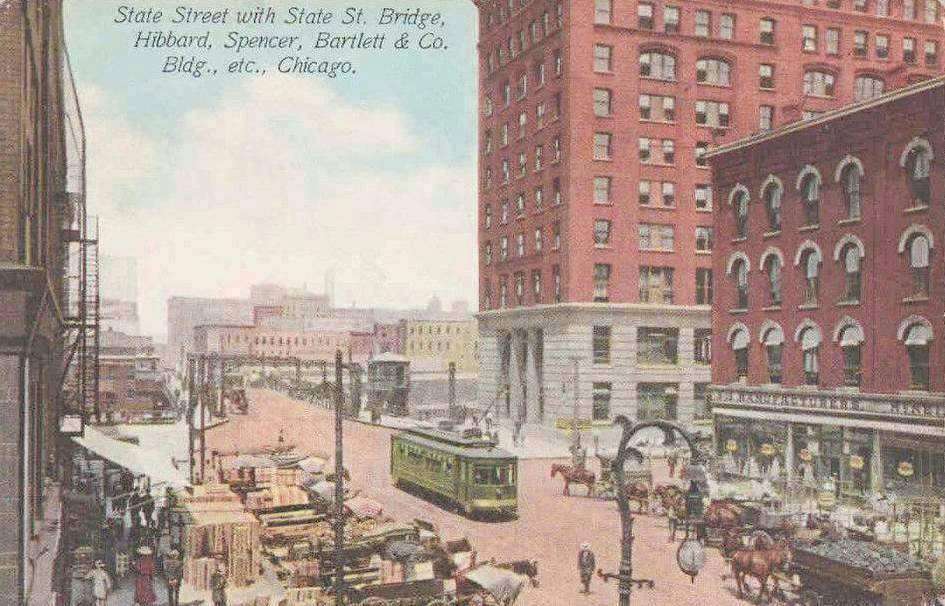

Sadly, there was never a second edition of Kelly’s book, despite the three additional decades that Hibbard eventually tacked on to its grand tale. From predictably humble beginnings in a skyscraper-less frontier town, the firm would grow at a rate nearly congruent with Chicago itself, building massive warehouses on the river and launching several iconic hardware brands (O-V-B “Our Very Best” and True Value among them) before finally taking its final bow in 1962.
Like their contemporaries Sears-Roebuck and Montgomery Ward, Hibbard, Spencer, Bartlett & Co. was largely a distributor rather than a manufacturer. The 15″ barn lantern in our museum collection, for example, might have been made by the Embury MFG Company of New York, then branded with the O-V-B lettering and shipped in bulk to Chicago.
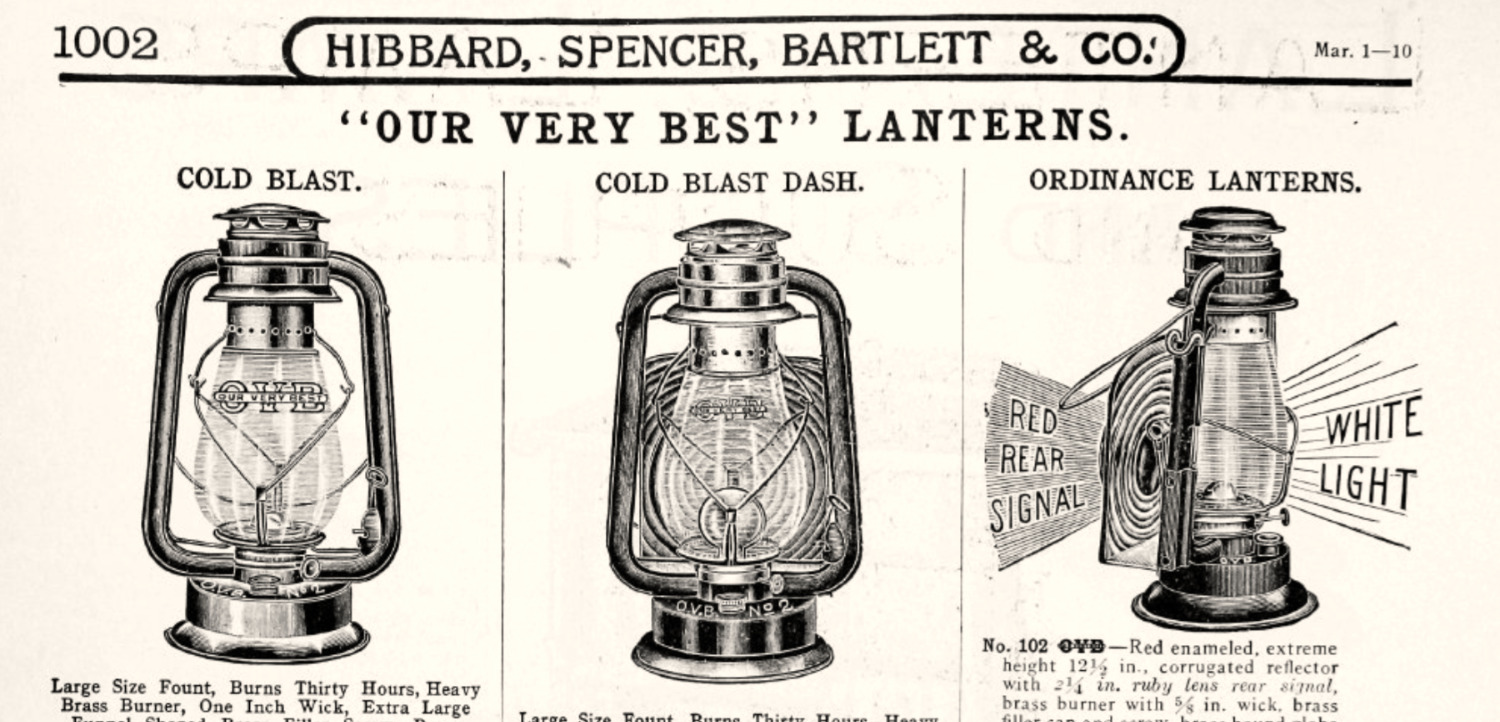 [OVB Lanterns featured in a Hibbard catalog from 1910]
[OVB Lanterns featured in a Hibbard catalog from 1910]
Depending on your definition, though, HSB&Co still “made” products. Rather than constructing them on assembly lines, they constructed identities for them—using innovative marketing schemes and smart business deals to earn a rock-solid reputation for first-class goods. The company’s 1,000 page catalogs condensed a city-block sized warehouse full of tools and appliances into a page-turning compendium of cool illustrations—from agricultural equipment to firearms, electrical gadgets, silverware, lighting, and bicycle parts. As Kelly suggested, hardware sales were more “human” because they touched every aspect of life.
The three namesakes of the operation—William Gold Hibbard (1825-1903), Franklin Fayette Spencer (1817-1890), and Adolphus C. Bartlett (1844-1922)—seemed to be connected in every aspect of their lives, as well. Though the three men arrived in Chicago years apart, with no prior knowledge of one another, they all shared a weirdly identical backstory; hailing from three small towns in upstate New York (Dryden, Gowanda, and Stratford, respectively), where they’d each worked as clerks in hardware stores. This cosmic familiarity helped endear them to one another early on, and it likely helped their business prosper, as well.
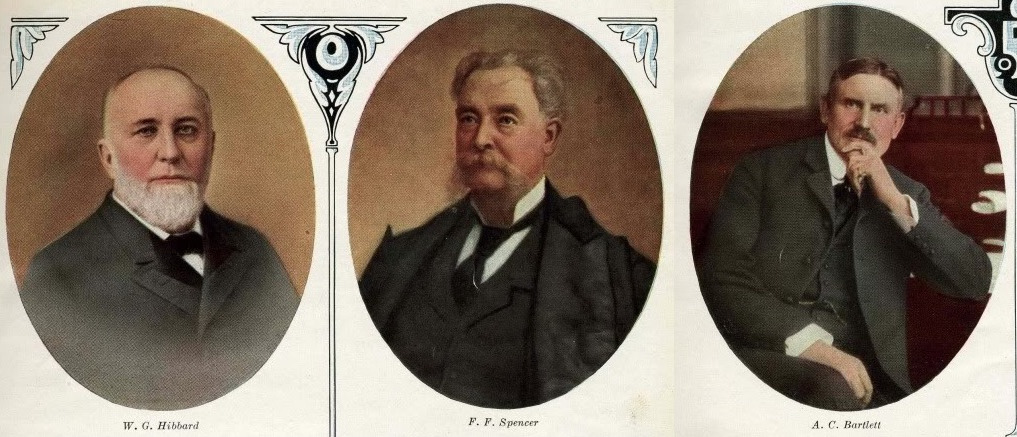 [Left to Right: William Hibbard (Founder), Franklin Spencer, and A.C. Bartlett]
[Left to Right: William Hibbard (Founder), Franklin Spencer, and A.C. Bartlett]
When a 24 year-old William Gold Hibbard landed on the shores of Lake Michigan in 1849 (there was no railway to Chicago yet), he supposedly had little more than the clothes on his back and $3 in his pocket. Having spent much of his youth helping out at his father’s hardware store back east, he found a gig doing the same at a similar shop in Chicago, William Blair & Company. Hibbard was now part of a Chicago population of less than 30,000, each carving out their own way in a city just entering its adolescence. The westward trend, however, was picking up plenty of steam, and by the time Hibbard decided to make the leap from store clerk to store owner six years later, his town had nearly tripled in size. He was getting into business when the getting was good.
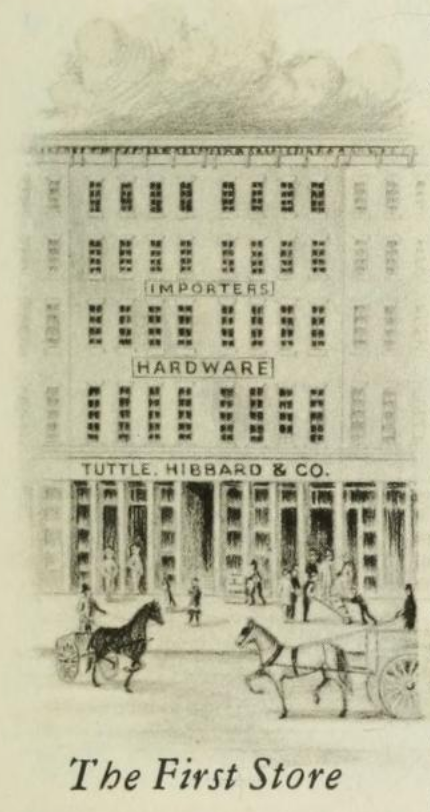 Originally, Hibbard partnered with a merchant named Nelson Tuttle, forming Tuttle, Hibbard & Co. The firm only employed about eight people but built up a pretty good stock of hardware in an unheated, ramshackle four-story building at 45 South Water Street. The nature of this original business was described in yet another of Hibbard’s special anniversary brochures—”Fifty Years of Progress” (1905):
Originally, Hibbard partnered with a merchant named Nelson Tuttle, forming Tuttle, Hibbard & Co. The firm only employed about eight people but built up a pretty good stock of hardware in an unheated, ramshackle four-story building at 45 South Water Street. The nature of this original business was described in yet another of Hibbard’s special anniversary brochures—”Fifty Years of Progress” (1905):
“The force of men, aside from the members of the firm, included a salesman, bookkeeper, receiving and shipping clerk combined, packer and porter. The stock of merchandise consisted mainly of staple and builders hardware, tinners’ supplies, and house furnishing goods. At that early date, the modern idea of assembling a great variety of goods under one roof, making it possible for the retailer to purchase small and frequent bills and to have them promptly and economically shipped, had not been born. The country merchant came to market each Spring and Fall, selected and purchased enough goods presumably to answer the requirements of his trade for six months, and then depended upon a very few orders by mail to keep good his assortment during the interim between his visits. The traveling salesman had not made his appearance in the commercial world, and the illustrated catalogue had not been thought of by the wildest dreamer.”
Within two years, the first Hibbard warehouse had gone up in a blaze. But the company soldiered on. You could consider it a practice run for what was to come.
Around this same time, in the mid 1850s, Franklin Spencer moved to Chicago as a representative of Jewett & Root, a stove manufacturer out of Buffalo. His office, as it happened, was next door to the Tuttle & Hibbard offices, and the fates soon aligned for a new friendship and business partnership—Hibbard, the straight-laced control-freak, and Spencer, the gregarious jokester and salesman. “It was a happy combination,” Kelly wrote in 75 Years, “for each had traits that supplemented the other’s. Their friends used to observe that even their whiskers were charmingly free from wasteful duplication, inasmuch as Hibbard’s were mainly on his chin and somewhat sedate, while Spencer’s were gayly festooned at each side, a sort of elaboration of his mustache, with the chin itself clean-shaven.”
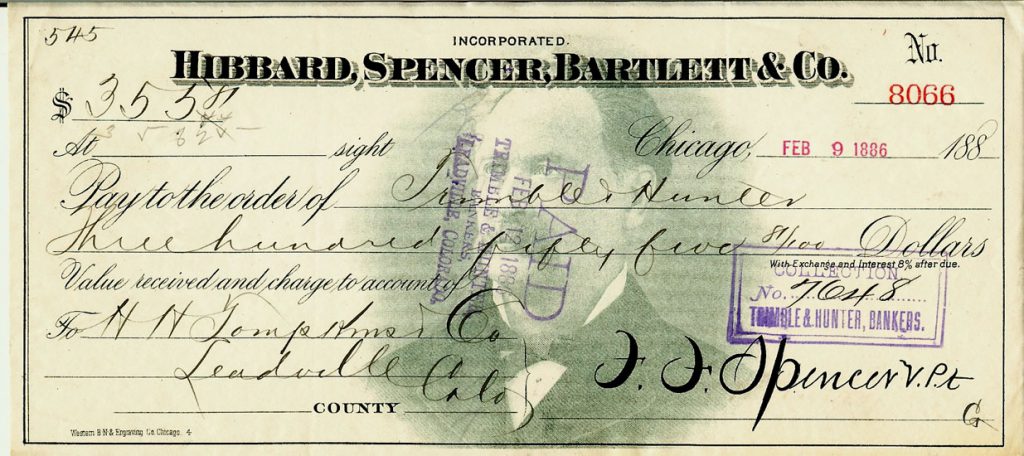
By the end of the Civil War, with hardware prices in a rough spot, Tuttle was out and Spencer was in, as the newly renamed Hibbard, Spencer & Co. moved into a big new warehouse at 92 Michigan Ave. Among their employees was a 21 year-old janitorial staffer named A.C. Bartlett, another ambitious kid from western New York.
The new Hibbard & Spencer headquarters happened to be right across from the Union Base-Ball Grounds, the old downtown ballpark where the Chicago White Stockings of the National Association played their home games. As another old company myth tells it, a large group of Hibbard employees had gone up to the roof of the warehouse on the afternoon of October 8, 1871, to watch a ballgame from a bird’s eye view. When Hibbard caught wind of this, he semi-angrily locked the roof access door, stranding his slacking employees outside to teach them a lesson. Later that evening, Hibbard finally let the men back inside and everyone presumably had an uncomfortable laugh about it. By the next morning, the Hibbard warehouse, the ballpark, and hundreds of other buildings were all gone—wiped off the map by the Great Chicago Fire.
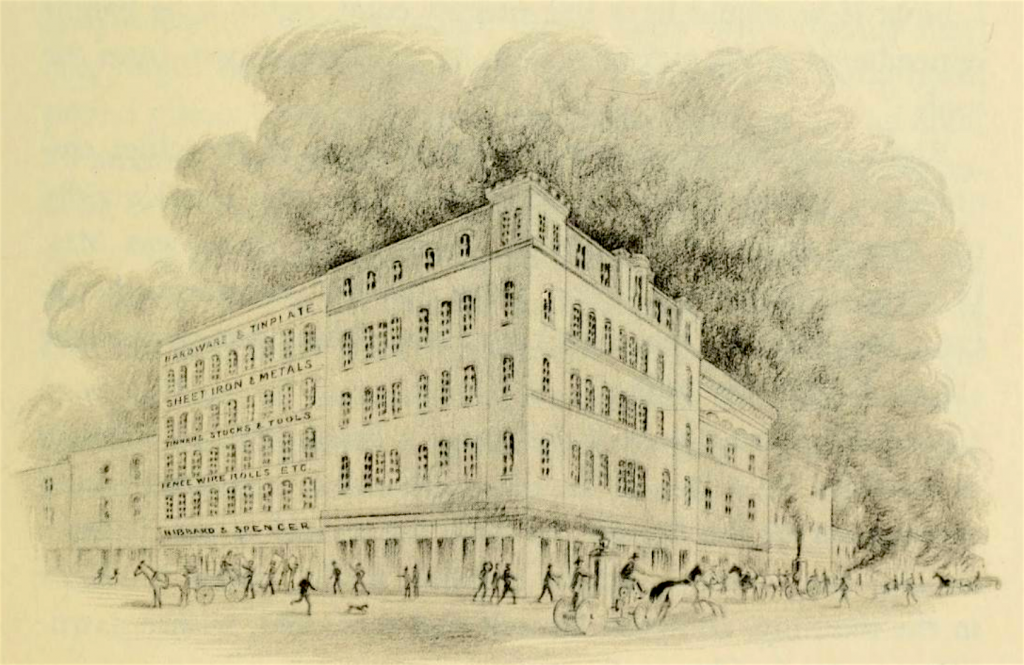 [Hibbard’s Michigan Ave. warehouse during Chicago Fire, 1871]
[Hibbard’s Michigan Ave. warehouse during Chicago Fire, 1871]
This could have been the end of the story, as it was for countless businesses. But in a twisted way, the fire actually launched Hibbard, Spencer & Bartlett into its golden age. The rebuilding of Chicago required one hell of a lot of hardware, you see, and the firm went above and beyond to rebuild not only its offices, but its relationships with its numerous buyers and manufacturing partners to supply the new demand.
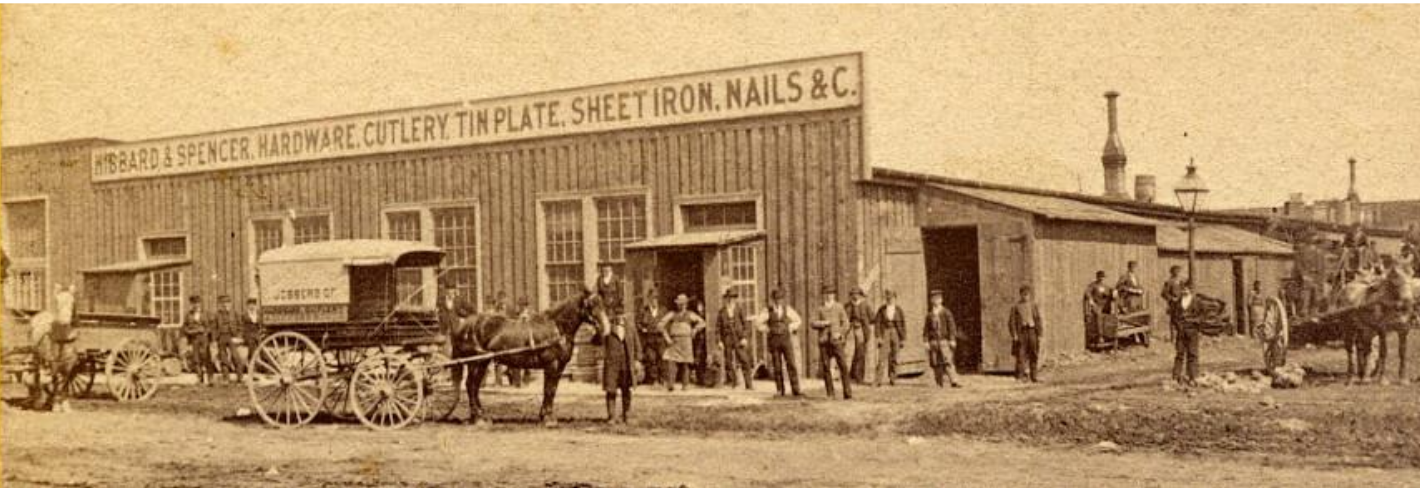 [A makeshift Hibbard warehouse in Chicago’s Grant Park area after the Great Fire of 1871]
[A makeshift Hibbard warehouse in Chicago’s Grant Park area after the Great Fire of 1871]
Two days after the fire, Hibbard had already gathered all the salvaged supplies he could and moved the company’s operations into his own house on Prairie Avenue. Work also began on a temporary new center of operations, located within the post-fire shanty town forming in what would later be known as Grant Park.
Perhaps most importantly, Hibbard assigned his up-and-coming protégé A.C. Bartlett [pictured below] the critical task of penning a letter to all of the company’s key clients. Bartlett, still just 27, came through in a big way.
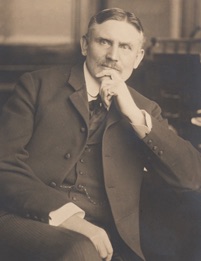 “Dear Sir,
“Dear Sir,
“In the terrible calamity that has overtaken our thriving city, we have suffered severely. Nearly our entire stock of goods is in ashes, and yet we have great reason to sincerely thank God for the preservation of our lives, and the solvency of our firm. In the past, we have endeavored by promptness and fair treatment of our customers to merit and receive the patronage of the hardware trade. We shall redouble our energies in the future.
“We have now a great personal favor to ask of each of our many friends, and of the trade throughout the Northwest, viz: that those who are indebted to us will remit with the least possible delay, and that you will favor us with your orders for goods. We have a remnant of our stock from which we will ship as far as possible, in perfect order, and the balance of your memorandum will be sent to New York, where two of our firm are engaged in filling orders and forwarding goods, with the UTMOST DISPATCH. We shall make prices cheap, and allow you difference in freight when goods are shipped from New York. Hoping to make it to your advantage to grant this great favor, and assuring you that it will be appreciated, we remain,
Yours truly,
Hibbard & Spencer”
In less than a year’s time, the company had thoroughly bounced back, opening a new, better warehouse at 16-32 Lake Street, employing 325 people. Bartlett’s hard work paid off personally, too, as he worked his way up to company secretary, and eventually got his name on the door in 1882, as the firm was re-named Hibbard, Spencer, Bartlett & Co.
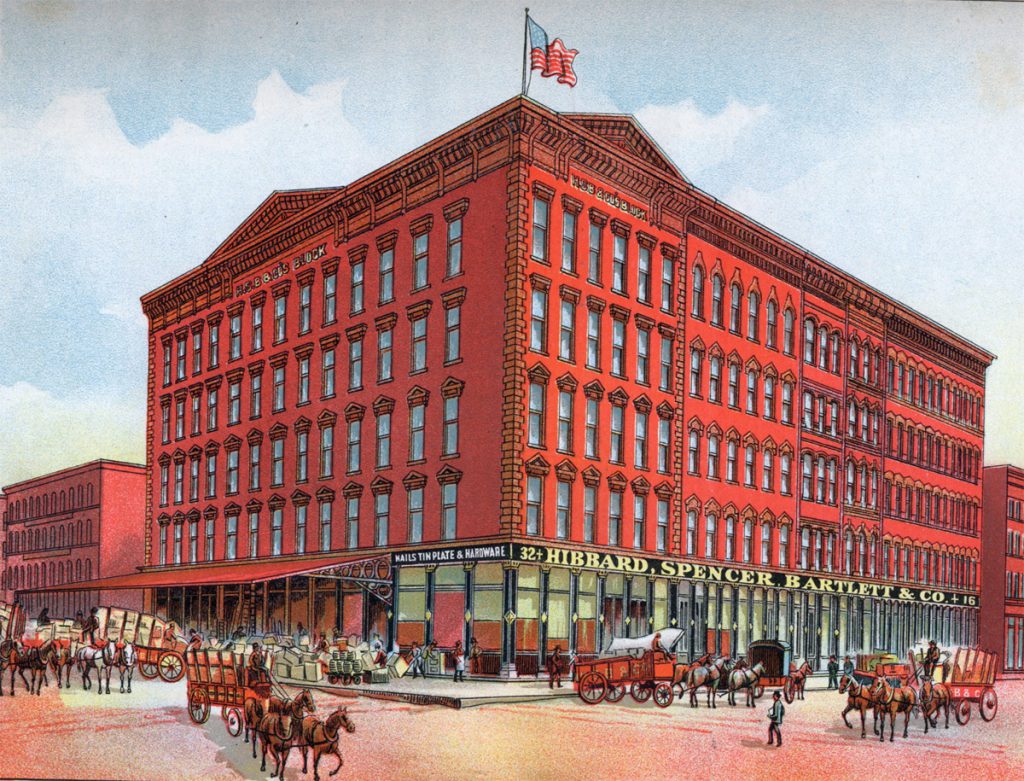 [The HSB&Co warehouse on Lake Street in the 1890s]
[The HSB&Co warehouse on Lake Street in the 1890s]
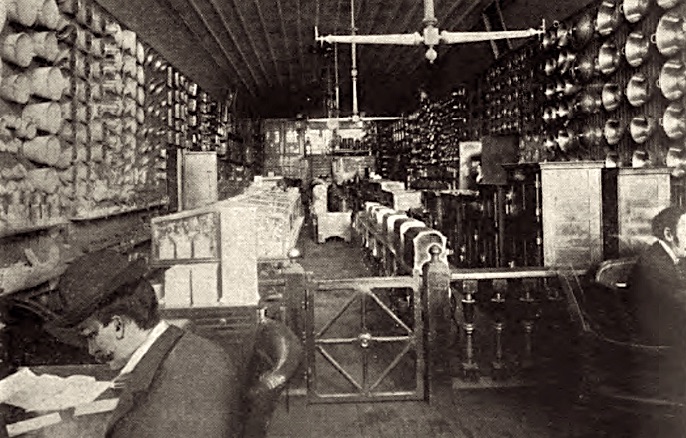 [Interior of Lake Street warehouse, c. 1890s]
[Interior of Lake Street warehouse, c. 1890s]
Now on semi-equal footing, Mr. H, Mr. S., and Mr. B “attained a degree of harmony and co-operation that was an example to everybody about them,” Kelly wrote. “Mr. Hibbard, an exceptionally shrewd judge of values, always did most of the buying. Mr. Spencer continued to be the credit man, and Mr. Bartlett looked after the selling, as well as the management of affairs in the building itself. He was among the first to think of organizing a sales force to go out on the road to call on the trade. To him is due in great measure the successful building up of the elaborate sales system that Hibbard, Spencer, Bartlett & Co. have developed.”
Bartlett, notably younger than his two mentors, would eventually ascend to the company presidency himself, and would deftly pilot the increasingly gigantic hardware dealer into the 20th century. In 1903, he opened yet another warehouse—a 10-story behemoth by the State Street Bridge on E. South Water Street. With most of the city’s wholesalers still on Lake Street, this was a bit of pioneering move for HSB&Co.
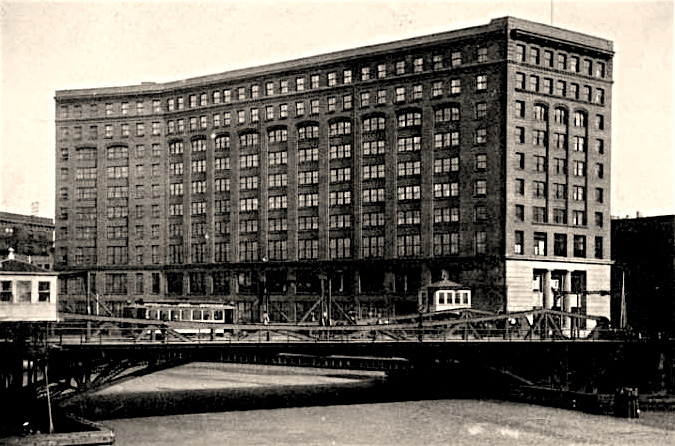 [Yet another new HSB&Co warehouse, State Street Bridge, c. 1903]
[Yet another new HSB&Co warehouse, State Street Bridge, c. 1903]
The same year the State Street headquarters opened, William Hibbard died at 79. The company founder would be widely remembered not just for the business he launched, but for his charitable side and important role in helping to rebuild Chicago after the “Great Conflagration.” In fact, all three of the names in HSB&Co had a similar reputation for generosity—profit sharing with employees, giving to local institutions, etc. William G. Hibbard Elementary School—built in 1915 in Albany Park—is still open more than 100 years later, as is the spectacular Bartlett Gymnasium (now a dining hall) on the University of Chicago campus.
After Bartlett, the next few company presidents were also longtime employees who’d similarly worked their way up the line—Charles Conover, J.J. Charles, and C.J. Whipple. It was under Charles that the last great Hibbard warehouse in Chicago was opened in 1925, at 211 E. North Water Street. It was an imposing fortress of a building—brown brick, 14 stories, 900,000 square feet.
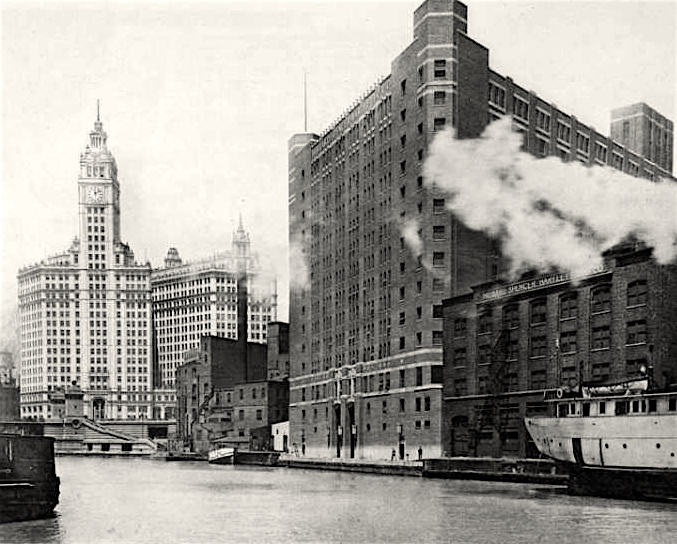 [The colossal HSB&Co building on North Water Street, opened in 1924, torn down in 1989]
[The colossal HSB&Co building on North Water Street, opened in 1924, torn down in 1989]
By 1930, the new Hibbard plant was storing more than 60,000 distinct products from across the company’s national network, all coming in via the Chicago River, rail, and truck. The nature of those products was changing, however.
For decades, horse-and-buggies products were a huge chunk of Hibbard’s business. By the 1920s? Not so much. Similarly, items like our OVB kerosene lantern—while still in circulation—were starting to look like antiques long before they got rusty.
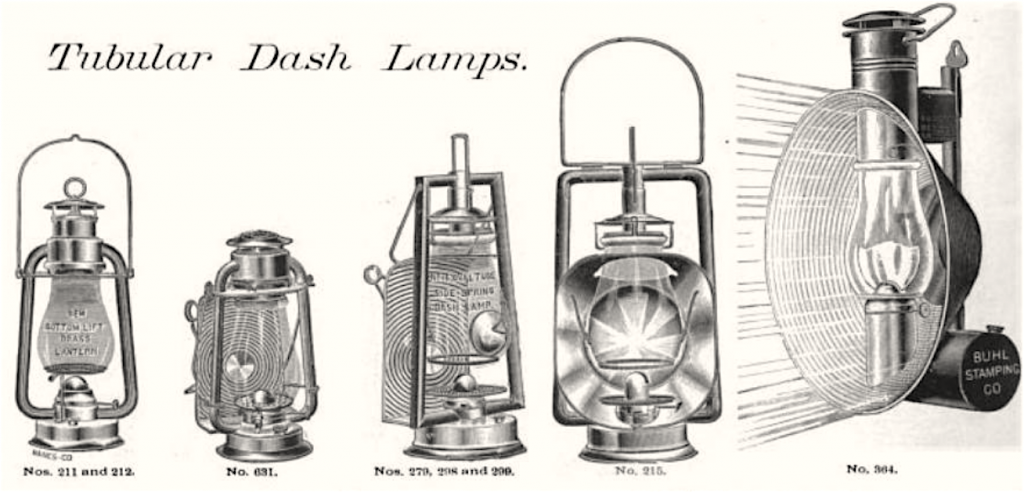 [Lamps from a 1891 Hibbard, Spencer & Bartlett catalog]
[Lamps from a 1891 Hibbard, Spencer & Bartlett catalog]
Back in the early 1900s, “one-half of one floor in the Hibbard, Spencer, Bartlett plant was devoted to lamp goods and lanterns,” Kelly wrote in 1930. “Stable lanterns, household lamps, overhead lamps, cleverly contrived with chains for lowering or raising them, lamps and lanterns in a variety of shapes and sizes. The wick and chimney business alone was considerable. Today the company still carries a few lamps and lanterns, but the volume of such business is a mere trifle. Electric-lighted homes and pocket flash-lights for out-of-doors have made the change.”
HSB&Co did their best to adapt during the Depression and war years, even as foreign competition and the general demise of the big wholesalers began to spell doom. They created the True Value brand of affordable products in 1932, and the concept was a hit.
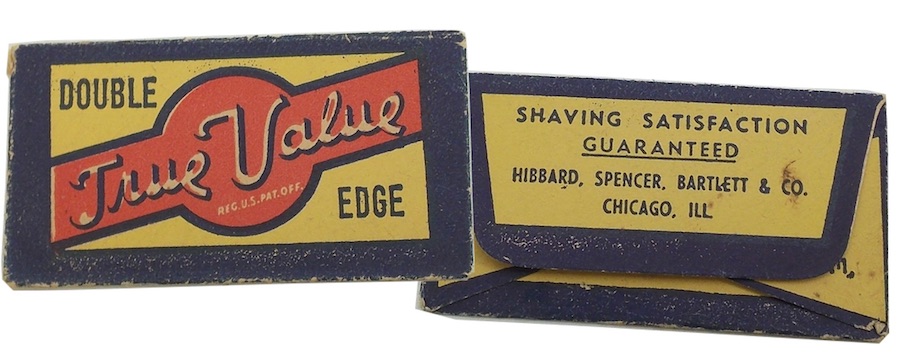
Sales numbers continued on a downward slope into the 1950s, though, and the end of the line finally arrived at the tail end of 1962, when the firm and all its holdings were sold for just $2.5 million to a relative upstart in the hardware business, John Cotter & Co.
In their wisdom, Cotter & Co. recognized the value (pun intended) of Hibbard’s respected True Value brand. Today, the True Value Company—still headquartered in Chicago—includes 5,000 retail stores as part of a national hardware cooperative. You know the name, now you know the names behind it.
For more Hibbard, Spencer & Bartlett stuff (as if you could possibly need any more), the museum also has an old OVB Food Chopper in the collection.
Mildly Fun Fact: Late in his life, Marshall Field—the beloved Chicago department store founder—married Franklin Spencer’s daughter Delia.
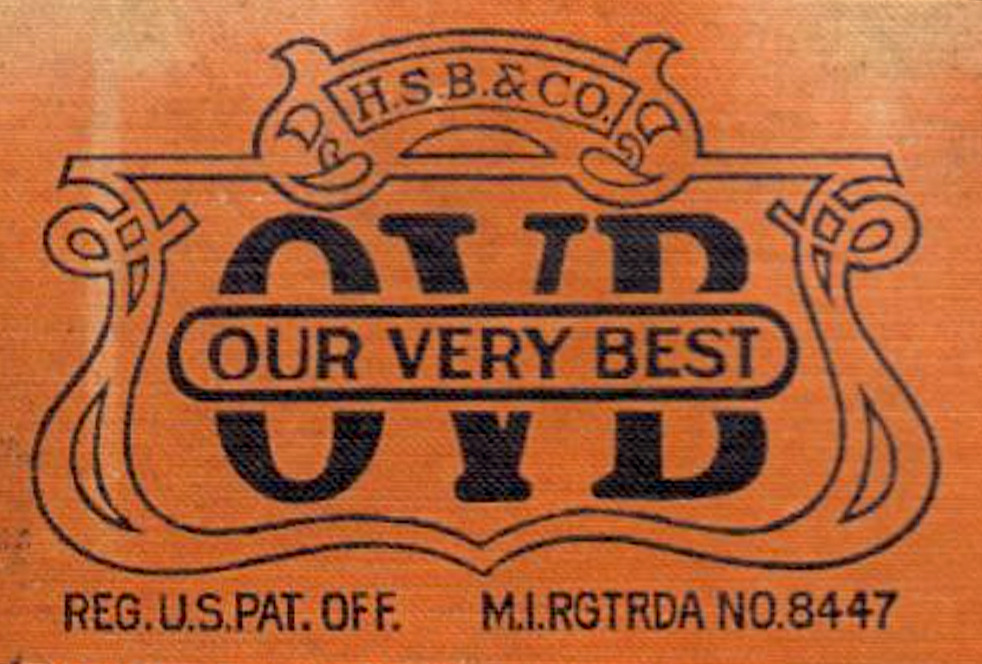
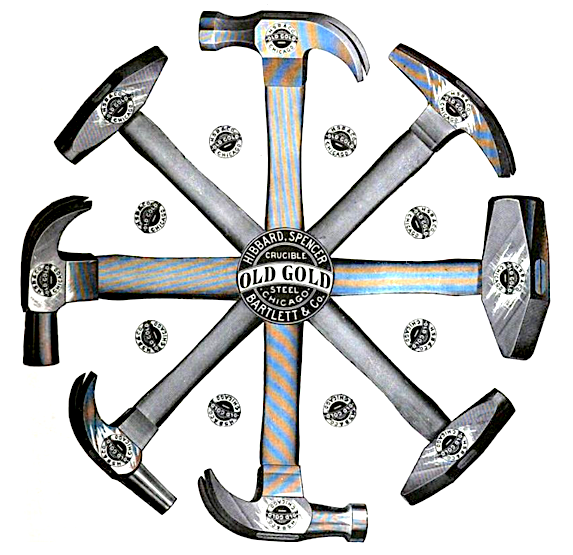
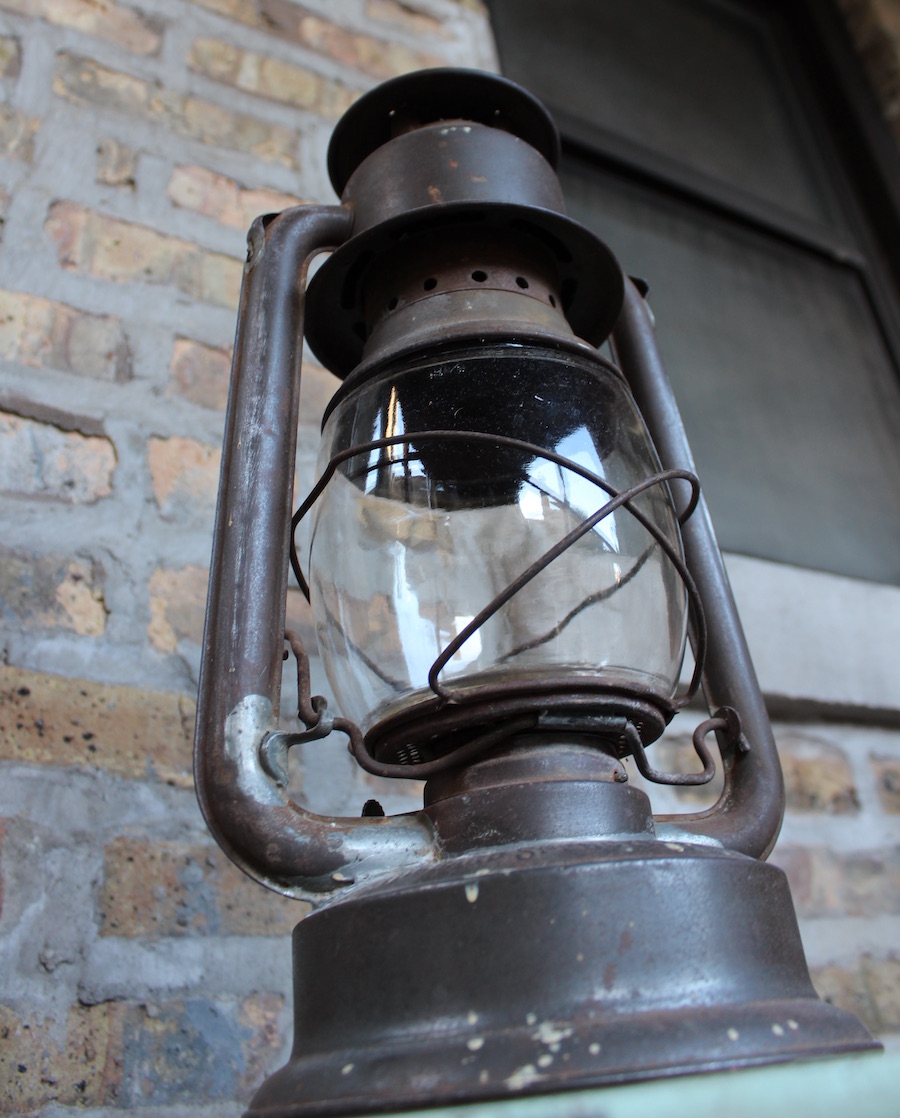
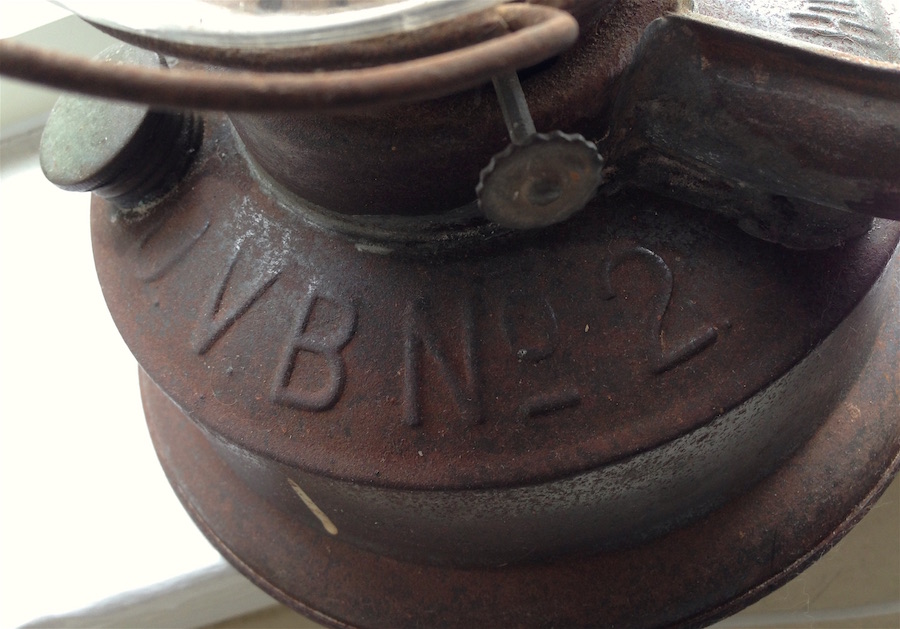
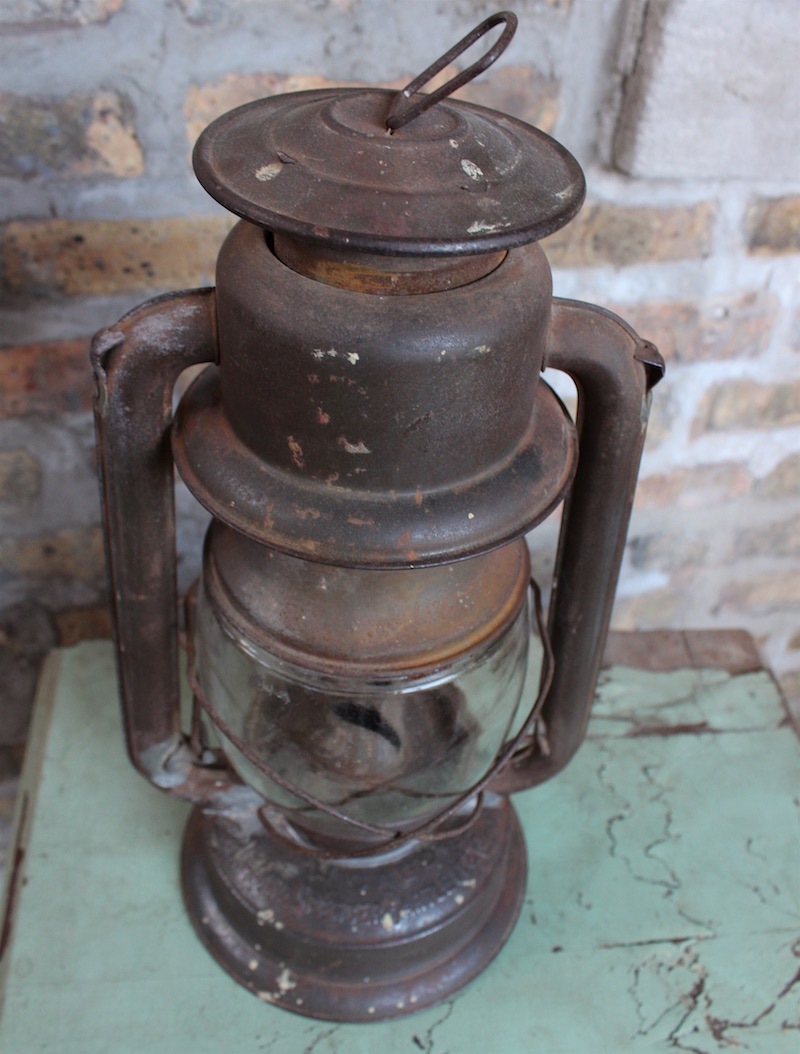
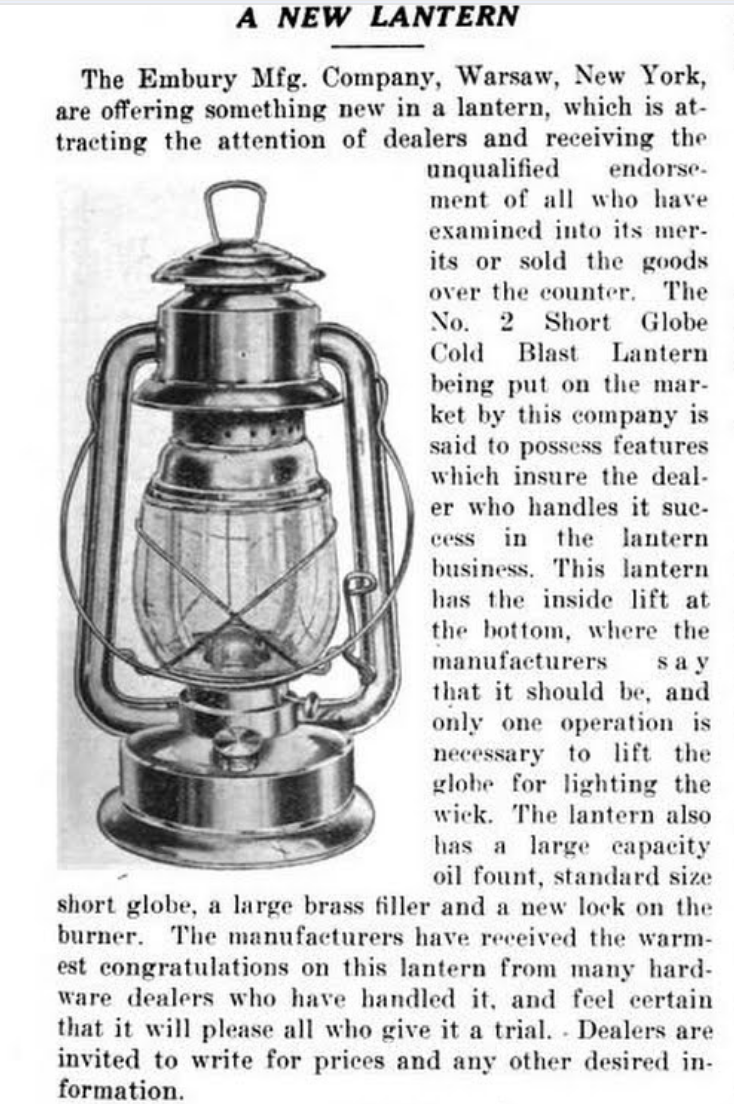 [A 1912 issue of the Hardware Reporter discusses the new Embury No. 2 Short Globe Cold Blast Lantern, a mighty similar design to our No. 2 OVB Lantern]
[A 1912 issue of the Hardware Reporter discusses the new Embury No. 2 Short Globe Cold Blast Lantern, a mighty similar design to our No. 2 OVB Lantern]
Sources:
75 Years of Hibbard Hardware, by Fred C. Kelly, 1930
Hardware magazine, Vol 31, 1905
Archived Reader Comments:
“I was looking for a brace bit to drill large holes and remembered I had one given to me but my father or grandfather. I searched around and found it. I am in the process of cleaning it and see it ha HSB and Co. OVB on the chuck. It is no. 1908 8 inch.” —Jim Neustadt, 2018
“Great article. I have 6 ordinary table forks from my great grandmothers table from HSB &Co. now I known more about them. They are good forks too, clean up nicely and don’ rust and we are using them daily… not bad for 100 years plus.” —Janell Kozak, 2018
“Great article about the history of the company–so often we purchase things without understanding how many people and businesses working together created what we hold in our hands.I recently purchased a No. 0 OVB lantern with a short red globe, and I’m having problems with trying to figure out when it might have been manufactured. There are no additional markings on either the lantern or the globe to indicate which railroad it might have been used for, but the 3.5-inch globe does have a lip on the bottom, versus the lipless ones that were manufactured by Corning.Would anyone be willing to point me to additional resources or help me date my lantern?” —S. Webb, 2018
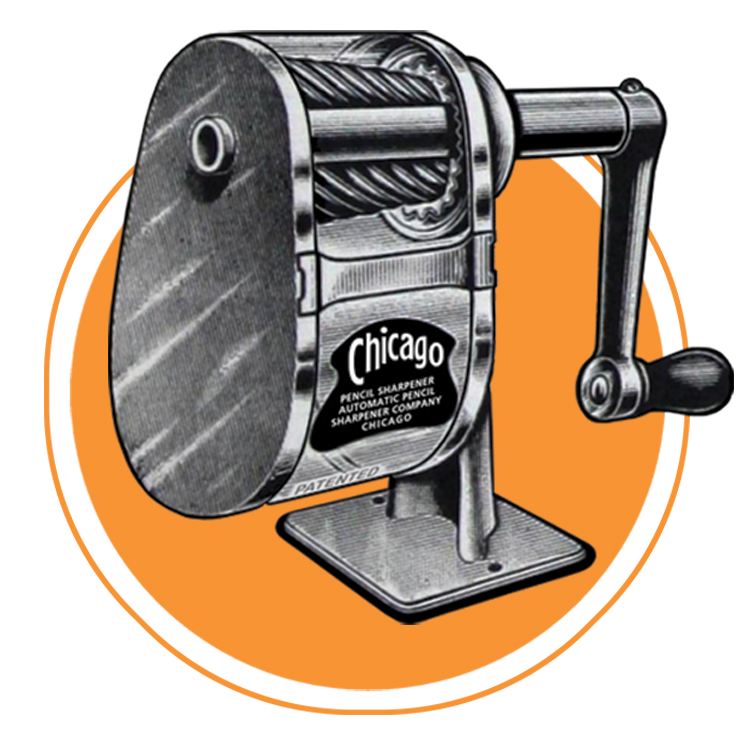
Fascinating history. I found the site while searching for the HSB & Co details as my S&W historical letter arrived today and it appears my New Model 3 Target .32/44 was shipped to the company in 1887. Shipped from Stockbridge Street to Lake & Wabash Ave, Chicago on the 15th July. I’m in the UK and have no idea how the pistol ended up here all the way from Chicago but at least I now have an idea of it’s movement in the USA. I wonder who it was bought for.
I recently obtained a Colt Archives historical letter on a Colt 1903 hammerless pocket automatic pistol, serial 237809. This item shipped to Hibbard, Spencer, Bartlett & Co on 18, January 1917. Any information you can provide would be greatly appreciated.
Just FYI. you are incorrect in identifying that lantern as a railroad lantern.
Railroads just did not use that type of lantern. They would’ve bought theirs from Adlake or Handlin.
What you have is a barn lantern.
If it had a red globe it would be a buggy lantern.
I have an old pipe wrench that just says Hubbard on it. It still works, I just used it to disconnect my garden hoses for the winter
I recently came across correspondence with Hubbard, Spencer, Bartlett & Co. letterhead dated Dec. 12, 1904 from W. D. Sprorsser Co., to a customer. It’s interesting to me but wondering if it would hold any value for someone else. Its context is in regards to a new type of book with all products (catalog) and furture catalog updates. It is signed by A.C. Bartlett.
I came across a egg incubator with kerosene heat. A damper on a rod on top. Do you know when it was made
I have my father’s 16 gauge double barrelled shotgun made by H S and B. It is a beautifully made piece, and was responsible for the demise of numerous pheasants and ducks in South
Dakota up until about 1960. Unfortunately, the forearm is missing and I very much like to know if anyone has one that I could buy? I was not able to find a serial number on the gun…only the engraved “Rev-O -Noc” and HS&B on the reciever. Thanks!
I recently acquired a pretty embroidery scissors labeled Hibbard, Spencer & Bartlett Co. As I’m trying to date the scissors in a time frame, when did the company start using the initials HS&B Co on their products?
We acquired a very old safe that has the words Rev-o-noc on the face of the door. When I googled it, it brought me to this page. I am curious if this safe was used in their store? I would love any inside on this if anyone had any.
I don’t have any actual information to offer you, but I noticed that “Rev-o-noc” spells “Conover” backwards. And Conover was one of the presidents of H.S.B. after the founders were gone. There’s probably a connection there!
I found an 1896 clothes wringer with HBS, Co. logo on it at a thrift store and was curious about it. It’s in great condition and still works with the writings clearly seen.
Looking for a replacement part for a vintage pruning shears. The spring is missing. Couldn’t tell if there may of been a clamp that would help hold it in place.
Can you tell me what is the difference between the No.2 lantern and the No.3? Thank you.
My travels during my work gave mean opportunity to look for kerosene lanterns. My collection has been reduced over the years but I still have a small collection with hot and cold blast models. It is comforting to light them on my porch in the evenings and enjoy the light and smell. My favorite by far is my OVB No3.
2022 augs 17th I’ve literally found a old logo of their company. We don’t know what it’s off of but we live in Arkansas and found it down here in a small town under some dirt after a huge rain. It’s pretty rusted but after some cleaning up we found the letters HSB & CO and then further down our very best. Missing the O sadly but I mean this is crazy to find it down this far from where the company was originally at. No number was found so idk that info but I mean it’s amazing
I have a Alligator wrench of HSB&CO It has OVB AND A No. 13 stamped on it and Pat July 26 98 I think means the year 1898. Do you have any history on this ranch and what it was used for? Thank you
Hi, I recently purchased an amazing Hibbard Bartlett Spencer tiny 1.5” brass fob in the shape of an axe head. It is fully embossed with lettering on both sides and has a very cool elaborate key chain attached to the fob. I would love to know how old it is?
Sincerely, Dave Gieseke
I recently purchased a H.S.B & Co. 15″ Cast Iron Bell. The yoke on the bell Has H.S.B. Co on one side of the Yoke and CHICAGO on the other side. Bell looks and sounds great. I’m thinking it’s late 1800’s but not sure.
I have a 5″ bench vise labeled. H.S.&B. Co. Chicago, Illinois, the other side has No. 175 on it. It also says Rev-O-Noc. I’d like to find out a little more about it, age etc.
I also own a bench vise with the same markings except it is a No.164. Charles Conover was promoted to president of the company sometime after Bartlett possibly in the 1920’s. The “Rev- O- Noc” marking on your vise is simply Conover spelled backwards.
I recently inherited. Lady Hibbard electric sandwich maker. It is in fine condition. How many were made and when. It has a #4825 on left and #606 on right after the volts. Of course it has company name on it.
I have a H.S.B. & Co. Chicago SunRacer Bike. Trying to find out the age?
I have a Cruso No 14 with a Y88R Base and Y65 Handle that can clamp to a table edge and spin a reverse threaded bolt quite fast by turning a handle like on a spinning wheel. I can’t figure out what it was designed and built for. Anyone?
I Have a Colt 1911 45 caliber US Navy Serial # C135016 that was sent to Hibbard,,Spencer, Bartlett & comp.
May 1 1923 Can anyone give me some information on this old Colt this has been completely Engraved.
I found a collector’s cup while going through my parent’s estate. Years ago they found the exact cup in a antique collector’s guide. They stated it had value and wanted us to be aware of it. My question is can you give me the value of this cup? It is a tin cup, dark color with white lettering that states”Compliments of Hibbard, Spencer & Bartlett & Co.” Any assistance would be appreciated.
Thank you.
Found HSB&co “our very best/pure silver metal”silverware. Was wondering how old it might be. Handles are smooth, pieces are a bit heavier than modern stainless steel utensils.
I was given an ARMY KNIFE made by Hibbard Spencer Bartlett & Co. It has a PAT.NO.7GI.878 on it and an OVB on the big knife. Can someone tell me more about it and what it is worth?
I have a Hibbard Spencer Bartlett OVB No. 2 lantern (brass) but then the globe is red and is stamped Dietz D Lite on one side and the other side of the globe is stamped LOC-NOB PAT D 12-4-23. I want to know what your thoughts are…is this something that someone “put” together using two different brands? Or where they made like that?
Was there a Hibbard-Hurd Railroad?
I recently purchased 2 HSB&Co. Saws. There were 3 of them but i bought the 2 that had carved handles. The larger of the 2 had a carved fern pattern along the palm part of the handle. I dont know if their worth anything, i was just drawn to them and saw the somewhat rusty, old saws with one having a bit of a crack in the handle, well, just..’beautiful.’
Im sure theres a story to them, one im sure ill never know but they looked so alone in that bin . I just had to give them a home. Thanks!
# 3450547 sewing machine We believe purchased Nov 1940 but made in 1930s. Can you provide any info on this machine?
Who made the pocket knives marketed by H.S.B., and during what years were the H.S.B. knives made and sold?
Thanks.
I have a H. S. B. & co. Cast iron waffle iron. No. 8 on one side. Pic of rooster on the other side. I would love to know more about it. When and where it was manufactured. Thank you.
https://www.shotgunworld.com/bbs/viewtopic.php?f=5&t=12473
Check out the link above. Scroll down in the post and click on the link for the double barrells. The link takes you to a 2000+ page catalog for the HSB&Co Catalog of that era which you would be able to read about the features and see the original price. Its page 1910 or in that ball park. Very interesting to look through the catalog.
Hope this helps!
I am looking for any information I can get on the HSB&Co OVB No3. I would like to know how it compares with the OVB No2 featured in this article, Would also like to know what my chances are of finding a cap for the reservoir and what the value is.
Have a lantern which has been in the family for at least a 100 years. It has raised lettering “O V B No 2” on the front of the base and “CHICAGO” on the rear. It stands 15″ tall. The glass globe, especially the bulls eye has a purplish tint to it. It resembles the Cold Blast Dash. Has a 7/8 wick, brass burner and the corrugated reflector. It was never painted.
Thought about firing it up some odd 40 years ago. However, when I removed the cap to fill it with fuel I could see something in the reservoir. It was pieces of dark brown paper with printing on it. Pulled the pieces of paper out and put the lantern back on the shelf with the other lanterns.
I have just got a fruit knive two blad with armer sausage on it would like to know when it was made
Looking for information on a 12 gauge rabbit ear breach shotgun. It is stamped genuine armory steel choke bore. H.S.B. and company chicago.
I found a Hibbard hand grinder #H101E. Would u know how old it is & if it worth anything
I have a display case from Hibbard Spencer Bartlett , state street bridge , Chicago . Was wondering how much it would be worth ?
I recently inherited a companion wood-burning stove with oven and I’m having a hard time finding information on it I’m wanting to restore some of it so I can have it if somebody could please help me out I’d greatly appreciate it
I recently obtained a Colt Archives historical letter on a Colt 1877 revolver, serial 92521. This item shipped to Hibbard, Spencer, Bartlett & Co on 06 September 1894.